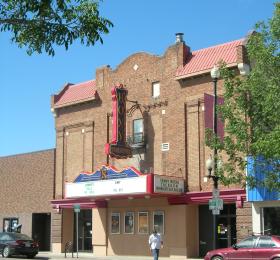Roxy Theatre
- Holding Bylaw
Description of the Historic Place
The Roxy Theatre (also known as the Coronet Theatre) is a brick, stone and concrete theatre built in 1930. Located in the Riversdale neighbourhood, the façade of the theatre exhibits the Spanish Villa style of architecture.
This historic place, located at 320 20th Street West, is listed under Bylaw No. 6770 (Holding Bylaw). This Bylaw provides short-term protection of the building from demolition by providing for a 60 day holding period in the event a demolition permit is received. Within that 60 day period heritage designation is considered by City Council.
Heritage Value
The heritage value of the Roxy Theatre lies in its architectural style. Designed by F.F. Le Maistre of Winnipeg, the Roxy Theatre's façade features brown brick with recessed architectural detailing in a lighter brown brick. It has decorative pattern bricklaying, limestone insets, and two curved limestone angle brackets at the upper corners. The overhanging tin roof imitates Spanish tiled roofs. There is a small window in the centre of the façade with a wrought iron balcony. An ornate neon sign hangs in front of the window and balcony, with a cantilevered advertising marquee located beneath.
The heritage value of the Roxy Theatre also lies in its importance as a landmark on 20th Street and its significance as a reminder of old theatre’s in Saskatoon. The Roxy came along at a transitional time in history. Vaudeville was dying out by the years 1927 and 1928, and as a result theatre owners were no longer building theatres with full, functional stages that could also serve as cinemas. The last theatre to be built with a functional stage was the Capitol Theatre, built in 1929, one year before the Roxy. There were no new theatres built in Saskatoon for another sixteen years, with the next being the Broadway Theatre in 1946.
At the time of its opening in 1930, the Roxy Theatre featured decorative windows and balconies set into plastered walls to make the auditorium look like an outdoor courtyard. This effect was heightened by a curved, dark blue ceiling fitted with lights that flickered like stars. Admission prices on opening night were 40 cents for adults and 25 cents for children.
Today, this building is the last remaining example of the ornate style of theatre built in Saskatoon between 1884 and 1931. It was renovated and reopened in 2005.
Source: City of Saskatoon Built Heritage Database
Character Defining Elements
Key elements which contribute to the heritage value of this historic resource include:
- Its location along 20th Street West;
- Its neon sign and marquee;
- Its Spanish villa style, evident in: its brick facade, limestone insets, curved limestone angle brackets at the building’s upper corners, its overhanging tin roof, and the curved parapet; and
- Its central window and wrought iron balcony

